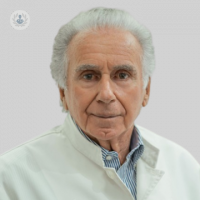Osseointegrated implants and ear microsurgery to restore hearing
Written by:In 1990 I presented the results of the first cochlear implants performed in Spain, since 1985. A path of hope was opened so that deaf children or deaf children could recover their hearing. Today this technology allows the hearing recovery of thousands of patients with profound hearing difficulties including total deafness.
Today's minute-enhanced hearing aids also help thousands of people around the world in some types of deafness. The correct adaptation and selection is very important for a satisfactory result. When conventional hearing aids or surgery are not effective, osseointegrated implants that have been of great help to certain types of people at the time of their hearing recovery. The most recent novelty in this type of hearing aid are the osseointegrated implants completely hidden under the skin that only require the adaptation by magnetic induction of a small external element when the patient wants to use it.. This makes it possible to hear patients who are totally deaf in one ear caused by infections, traumatisms, malformations, or in which tumors of the auditory nerve have been removed and whose only option to hear is through these implants.
Ear microsurgery
However, the microsurgery of the ear and the use of lasers are still the best solution for certain types of deafness such as otosclerosis that causes the fixation of a small ear bone, the abutment, and that must be replaced by a prosthesis, to restore its mobility and, therefore, hearing.
Otitis or chronic otorrhea cause hearing destruction in addition to infections that endanger other nearby structures. The surgery allows to control most of these infections correcting the infection and getting, in many cases, the hearing recovery.
The otologic vertigo , the so-called Meniere's disease , is a quite frequent pathology caused by an injury in the labyrinth and inner ear, which causes violent vertiginous episodes, tinnitus and progressive hearing loss. In patients who do not respond to medical treatment it is always possible to control them with the surgical option that gives excellent results.
Another type of deafness that exists caused by a pathology, the acoustic neurinoma (vestibular schwannoma), is potentially very serious due to the intercranial progression of a tumor that although benign may be dangerous for the patient due to its characteristics. Its extirpation is currently done through microsurgery, laser and ultrasound , although in many cases it would produce total deafness when having to section the auditory nerve.
Nowadays, it is possible to recover the hearing of these patients with the latest generation osseointegrated implants that allow hearing to be captured on the affected side and transmitted to the healthy ear giving the impression that the patient hears through the deaf ear.
In general, we can say that the current microsurgery sometimes associated with the increasingly advanced electronics allows the recovery of hearing in patients who at other times would be terminally ill.



